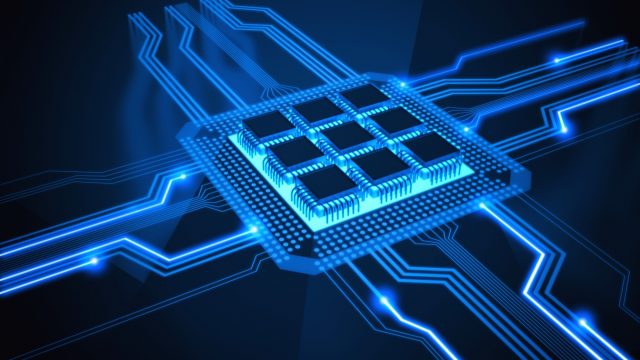Hyperthreading is a technology that increases the performance of processors. It allows a single processor to execute multiple threads simultaneously. This means that the processor can handle more tasks at once, resulting in faster and more efficient performance.
Hyperthreading was first introduced by Intel in 2002 with their Pentium 4 processors. It has since been implemented in many of their processors, including their Core i series.
The main benefit of hyperthreading is that it allows for better multitasking. With hyperthreading, a single processor can handle multiple tasks at once, without sacrificing performance. This is particularly useful for tasks that require a lot of processing power, such as video editing, 3D rendering, and gaming.
Hyperthreading works by creating virtual cores within a physical core. This means that a single physical core can execute two threads at once as if it were two separate cores. This is achieved by duplicating some of the resources within the core, such as the program counter and registers. This allows the core to handle two threads simultaneously, without the need for additional hardware.
While hyperthreading can improve performance in many cases, it is not always necessary. Some applications may not benefit from hyperthreading, and in some cases, it may even cause a slight decrease in performance. This is because hyperthreading can cause some resources within the core to be shared between the two threads, which can lead to some performance overhead.
In addition, there have been some concerns about the security implications of hyperthreading. It has been suggested that hyperthreading can make a system more vulnerable to certain types of attacks, such as side-channel attacks. However, Intel has stated that they have implemented measures to mitigate these risks and that hyperthreading is safe to use.
Hyperthreading is a useful technology that can improve performance in many cases. However, it is not always necessary, and there may be some security risks associated with its use. As with any technology, it is important to weigh the benefits against the potential risks before deciding whether to use it or not.

The Benefits of Hyperthreading
Hyperthreading is a technology that allows a single physical core of a processor to act as two logical cores. This means that the processor can handle two threads of instructions simultaneously, improving its overall performance. Hyperthreading is particularly useful for tasks that require multi-tasking, such as running background applications while playing games or streaming content.
Hyperthreading provides several benefits, including:
1. Improved multitasking: With hyperthreading, your computer can run multiple tasks simultaneously without any lag or performance issues. This is beneficial for people who need to run multiple applications at the same time, such as video editors, game streamers, or programmers.
2. Enhanced gaming experience: Hyperthreading can improve the performance of your computer while gaming, allowing for a smoother and more seamless experience. This is especially important for gamers who need to maintain a high frame rate and low latency.
3. Faster data processing: Hyperthreading can also improve the speed at which your computer processes data, making it an excellent choice for people who work with large data sets, such as scientists or researchers.
Hyperthreading is an excellent technology that can significantly improve the overall performance of your computer. It is particularly useful for multitasking, gaming, and handling large data sets.
The Impact of Hyperthreading on Performance
Hyperthreading is a technology that allows a single physical processor to behave like two logical processors, which can execute multiple threads simultaneously. According to Intel, the first hyper-threading implementation used only 5% more die area than the comparable non-hyperthreaded processor, but the performance was 15–30% better. This means that hyperthreading can indeed improve performance by allowing the processor to handle more tasks simultaneously, thus reducing the time it takes to complete them.
Intel claims that hyperthreading can provide up to a 30% performance improvement compared with an otherwise identical, non-simultaneous multithreading Pentium 4. This is because hyperthreading enables the processor to better utilize its resources, such as its caches and execution units, by allowing them to be shared between two logical processors. This can result in faster processing times and improved overall system performance.
Hyperthreading can improve performance by allowing a single physical processor to behave like two logical processors, which can execute multiple threads simultaneously, resulting in faster processing times and improved overall system performance.
Comparing Hyperthreading and Multithreading
Hyperthreading and multithreading are two terms that are often used interchangeably, but they are not the same thing. Hyperthreading is a technology that allows a single physical processor to act as if it were two virtual processors. This is accomplished by duplicating certain parts of the processor that are used less frequently, such as the program counter and the registers. By doing this, the processor can switch between two threads more quickly, allowing for increased performance.
Multithreading, on the other hand, is a programming technique that allows multiple threads to run concurrently within a single process. Each thread is a separate path of execution within the process, and they can share data and resources. Multithreading is often used in applications that need to perform multiple tasks simultaneously, such as web servers or video editing software.
To summarize, hyperthreading is a hardware technology that allows a single processor to act as two virtual processors, while multithreading is a programming technique that allows multiple threads to run concurrently within a single process.
Should Hyperthreading Be Turned Off?
Hyperthreading is a technology that allows a CPU to execute multiple threads simultaneously. While this can improve performance in certain situations, there have been concerns raised about its security implications. Intel, the manufacturer of the CPUs that support hyperthreading, has stated that this technology does not pose a security risk. However, if you are concerned about the potential risks, disabling hyperthreading may be a good idea.
Another reason to turn off hyperthreading is to avoid straining your CPU. Hyperthreading can increase the workload on your CPU, which can result in higher temperatures and reduced lifespan. If you are running applications that do not benefit from hyperthreading, turning it off may help to reduce the strain on your CPU.
Ultimately, whether or not to turn off hyperthreading depends on your specific needs and concerns. If you are not experiencing any issues with your CPU and are not worried about security risks, there may be no need to turn off hyperthreading. However, if you are experiencing performance issues or have concerns about security, disabling hyperthreading may be a good option.
Conclusion
Hyperthreading is a technology that allows a single physical processor to act as two virtual processors, improving performance in multitasking scenarios. This feature is particularly useful for gamers and content creators who need to run multiple applications simultaneously without experiencing lag. While there have been some concerns about potential security vulnerabilities associated with hyperthreading, Intel has assured users that the feature is safe to use. hyperthreading is a valuable technology that can significantly enhance the performance of your CPU, and it is worth considering if you are looking to upgrade your system or improve your multitasking capabilities.








